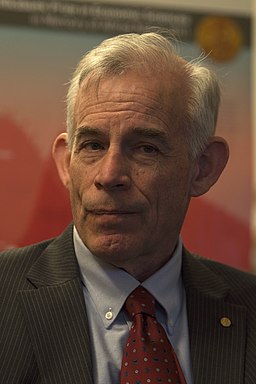
Christopher A. Sims
1942-

Christopher Sims was awarded, along with Thomas Sargent, the 2011 Nobel Prize in Economic Sciences. The Nobel committee cited their “empirical research on cause and effect in the macroeconomy.” The economists who spoke at the press conference announcing the award emphasized Sargent’s and Sims’ analysis of role of people’s expectations.
One of Sims’s earliest famous contributions was his work on money-income causality, which was cited by the Nobel committee. Money and income move together, but which causes which? Milton Friedman argued that changes in the money supply caused changes in income, noting that the supply of money often rises before income rises. Keynesians such as James Tobin argued that changes in income caused changes in the amount of money. Money seems to move first, but causality, said Tobin and others, still goes the other way: people hold more money when they expect income to rise in the future.
Which view is true? In 1972 Sims applied Clive Granger’s econometric test of causality. On Granger’s definition one variable is said to cause another variable if knowledge of the past values of the possibly causal variable helps to forecast the effect variable over and above the knowledge of the history of the effect variable itself. Implementing a test of this incremental predictability, Sims concluded “[T]he hypothesis that causality is unidirectional from money to income [Friedman’s view] agrees with the postwar U.S. data, whereas the hypothesis that causality is unidirectional from income to money [Tobin’s view] is rejected.”
Sims’s influential article “Macroeconomics and Reality” was a criticism of both the usual econometric interpretation of large-scale Keynesian econometric models and of Robert Lucas’s influential earlier criticism of these Keynesian models (the so-called Lucas critique). Keynesian econometricians had claimed that with sufficiently accurate theoretical assumptions about the structure of the economy, correlations among the macroeconomic variables could be used to measure the strengths of various structural connections in the economy. Sims argued that there was no basis for thinking that these theoretical assumptions were sufficiently accurate. Such so-called “identifying assumptions” were, Sims said, literally “incredible.” Lucas, on the other hand, had not rejected the idea of such identification. Rather he had pointed out that, if people held “rational expectations” – that is, expectations that, though possibly incorrect, did not deviate on average from what actually occurs in a correctable, systematic manner – then failing to account for them would undermine the stability of the econometric estimates and render the macromodels useless for policy analysis. Lucas and his New Classical followers argued that in forming their expectations people take account of the rules implicitly followed by monetary and fiscal policymakers; and, unless those rules were integrated into the econometric model, every time the policymakers adopted a new policy (i.e., new rules), the estimates would shift in unpredictable ways.
While rejecting the structural interpretation of large-scale macromodels, Sims did not reject the models themselves, writing: “[T]here is no immediate prospect that large-scale macromodels will disappear from the scene, and for good reason: they are useful tools in forecasting and policy analysis.” Sims conceded that the Lucas critique was correct in those cases in which policy regimes truly changed. But he argued that such regime changes were rare and that most economic policy was concerned with the implementation of a particular policy regime. For that purpose, the large-scale macromodels could be helpful, since what was needed for forecasting was a model that captured the complex interrelationships among variables and not one that revealed the deeper structural connections.
In the same article, Sims proposed an alternative to large-scale macroeconomic models, the vector autoregression (or VAR). In Sims’s view, the VAR had the advantages of the earlier macromodels, in that it could capture the complex interactions among a relatively large number of variables needed for policy analysis and yet did not rely on as many questionable theoretical assumptions. With subsequent developments by Sims and others, the VAR became a major tool of empirical macroeconomic analysis.
Sims has also suggested that sticky prices are caused by “rational inattention,” an idea imported from electronic communications. Just as computers do not access information on the Internet infinitely fast (but rather, in bits per second), individual actors in an economy have only a finite ability to process information. This delay produces some sluggishness and randomness, and allows for more accurate forecasts than conventional models, in which people are assumed to be highly averse to change.
Sims’s recent work has focused on the fiscal theory of the price level, the view that inflation in the end is determined by fiscal problems—the overall amount of debt relative to the government’s ability to repay it—rather than by the split in government debt between base money and bonds. In 1999, Sims suggested that the fiscal foundations of the European Monetary Union were “precarious” and that a fiscal crisis in one country “would likely breed contagion effects in other countries.” The Greek financial crisis about a decade later seemed to confirm his prediction.
Christopher Sims earned his B.A. in mathematics in 1963 and his Ph.D. in economics in 1968, both from Harvard University. He taught at Harvard from 1968 to 1970, at the University of Minnesota from 1970 to 1990, at Yale University from 1990 to 1999, and at Princeton University from 1999 to the present. He has been a Fellow of the Econometric Society since 1974, a member of the American Academy of Arts and Sciences since 1988, a member of the National Academy of Sciences since 1989, President of the Econometric Society (1995), and President of the American Economic Association (2012). He has been a Visiting Scholar for the Federal Reserve Banks of Atlanta, New York, and Philadelphia off and on since 1994.
About the Author
David R. Henderson is the editor of The Concise Encyclopedia of Economics. He is also an emeritus professor of economics with the Naval Postgraduate School and a research fellow with the Hoover Institution at Stanford University. He earned his Ph.D. in economics at UCLA.
